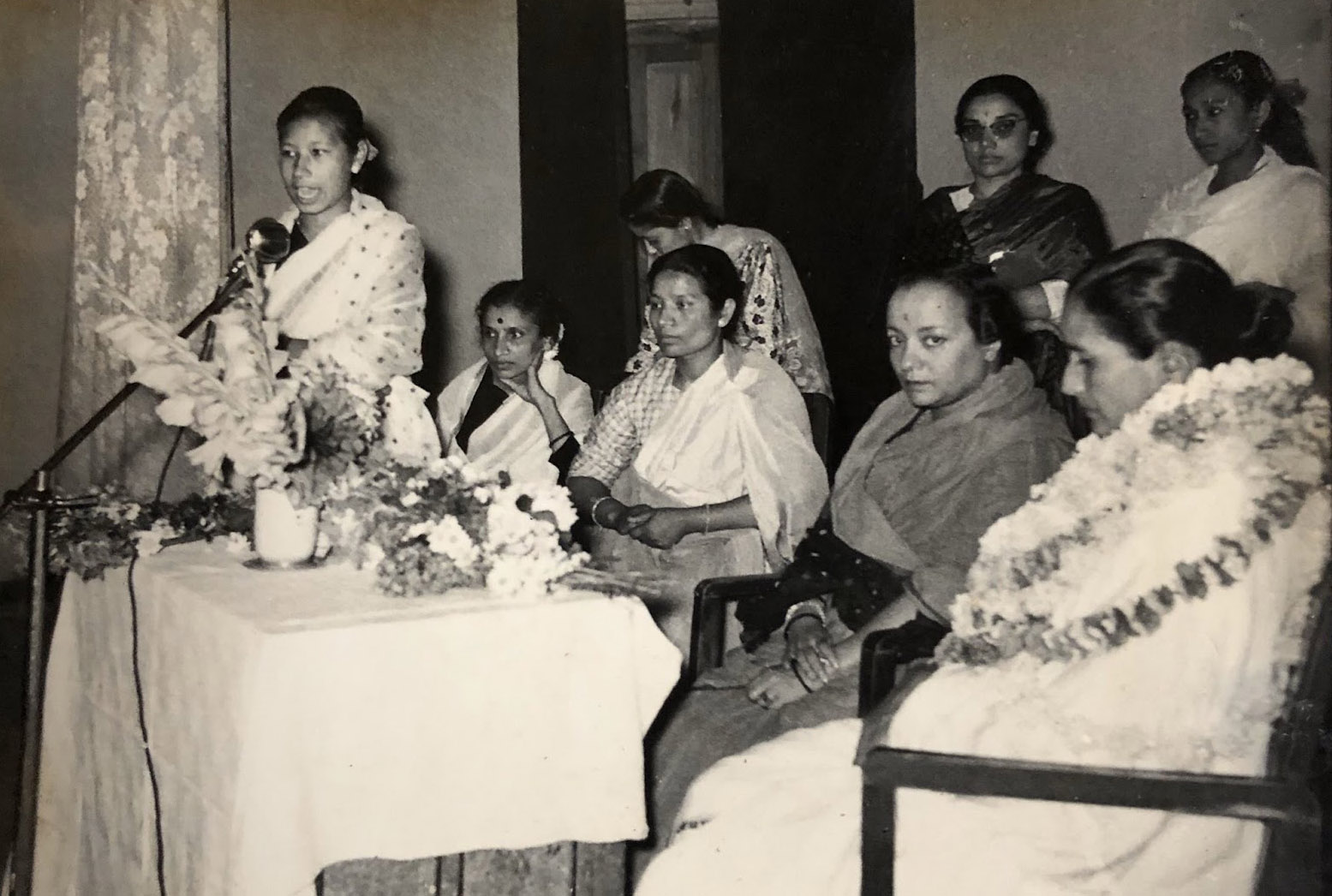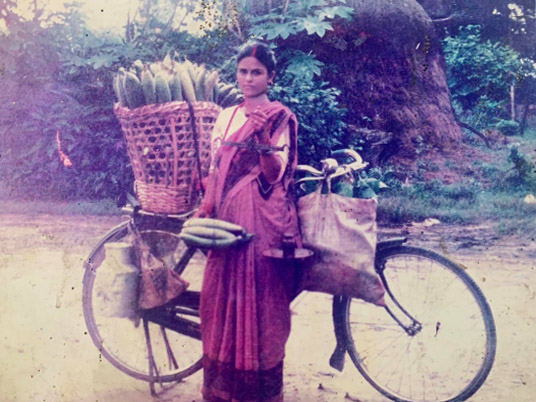The article is Part 2 of a series on cycling in Nepal. For Part 1, A history of cycling in the Kathmandu Valley, click here.
Sarojini Manandhar started riding a bicycle on Kathmandu’s streets in the late 1940s. Back then, few if any women cycled in the city. Manandhar would ride her bicycle draped in a sari or long skirt. Riding a bicycle—primarily designed for men—in such attire couldn’t have been comfortable, and Nepali society at the time wouldn’t have approved of women, especially those married, being physically active outside of their homes.
Yet Manandhar was young and fierce and rode a bicycle to explicitly break conservative social norms and pronounce that women were as capable as men.
Born into a progressive Newa business family in 1937 in Kathmandu’s core city area and educated at a time when most of Nepali society didn’t even consider schooling girls, Manandhar was vocal about women’s rights from a young age. She was one of the few fortunate girls to be able to receive a formal education. Her father, Asta Narayan Manandhar, was a revolutionary who challenged societal norms by sending his daughters to school, treated his sons and daughters equally, and supported the growing movement against the Rana regime, according to his granddaughter Sumitra Manandhar Gurung.
Sarojini Manandhar was thus educated at the Shanti Nikunja School, Nepal’s first co-ed high school, established in 1945. The school was one of the bases for revolution against the autocratic Rana regime, and a place for Manandhar’s political awakening. She participated in the movement for democracy alongside her close friend Mangala Devi Singh, a pioneer women’s rights activist and prominent democratic activist. The Rana regime would eventually fall in 1950, after 105 years in power.

After the end of the autocratic Rana regime, Manandhar continued to work in women’s rights through the Nepal Mahila Sangh (Nepal Women’s Association) which Mangala Devi Singh co-founded in 1947. In 1960, Manandhar started teaching at the Kanya School, now Padma Kanya Multiple Campus. While attending meetings of the Mahila Sangh or going to work as a teacher, she always rode her bicycle, said Sheela Manandhar, Sarojini’s daughter.
“Whenever Sarojini Manandhar visited our home, my mother-in-law [Mangala Devi Singh] would introduce her as the first Nepali woman cyclist,” recalled Sirjana Singh, who is a social worker.
Cycling came naturally to Manandhar, as her family owned a bicycle shop—her father, Asta Narayan, had started Kathmandu’s first bicycle shop in 1925. But in the 40s and 50s, cycling was the exclusive province of men. Women, particularly married women, on wheels was unthinkable. But Manandhar’s case was different; she had the support of her family and she continued cycling well into the 60s, even after marriage.
Riding to freedom
Before the 60s, it was mostly the wealthy elite males who rode bicycles in Nepal. Only after 1960 did Kathmandu’s cycling culture expand to the middle-class and beyond. But even then, it remained a solely male pursuit. Unlike in Europe — where women started cycling after the introduction of the “safety bicycle” in 1889 — women in Kathmandu were largely discouraged from taking up cycling. European women took to cycling in droves, especially after joining the industrial labor force in the early 1900s, and by the 60s, women were cycling extensively, as outlined in the book Cycling and Sustainability:
When women entered the labor market to a greater extent in the 1960s, and their daily transport need increased, cycling women were an incontestable part of the cycling cultures in The Netherlands and Denmark. Cycling was integrated into typical women’s professions such as daycare and senior citizen care services as an option for travel and transport. Today women cycle slightly more than men and arguably have become primary carriers of the everyday cycling culture.
In the late 19th and early 20th centuries, bicycles symbolized women’s emancipation in the West. Suffragettes rode bicycles to assert their rights. In 1896, Munsey’s Magazine wrote that a bicycle was more than a mere mobility tool for women:
To men, the bicycle in the beginning was merely a new toy, another machine added to the long list of devices they knew in their work and play. To women, it was a steed upon which they rode into a new world.
But in Nepal, cycles were initially limited to those who could afford them. Born in 1930, Kishori Rana started cycling when she was around 12 years of age, inside the premises of Bagh Durbar, where she grew up. Despite being a member of the elite Rana family, her activities as a woman too were limited. She cycled until she was 17, which is when she got married and as a daughter-in-law, she wasn’t allowed to cycle any more.
In the 1950s, Hasina Joshi, then a teenager, used to cycle around her Thimi neighborhood, swim in the Bagmati river, and go to cinemas despite reservations from her family. She too had to give up cycling after marriage.

At the time, Nepali society was much more patriarchal and women were circumscribed to household chores like cooking, cleaning, raising children, and farming. In an interview with Media Nepal in 1985, Mangala Devi Singh recounts a meeting in the 40s with then Rana prime minister Padma Shumsher to discuss women’s issues. Padma Shumsher apparently chided her, saying, “Why do you need women’s rights? A woman’s ideal characteristic is to stay home and serve the members of the household.”
“Society was conservative and married women especially were not allowed to go outside their homes and socialize,” said urban planner Kirti Joshi, explaining why her mother Hasina Joshi had to give up cycling after marriage.
In his book Everyday Technology: Machines and the Making of India’s Modernity, historian David Arnold recounts a similar pattern in Indian society before the 1960s:
In general, cycling was not common once women reached marriageable age. There was an argument (made mostly by men) that it was dangerous for young women to ride bicycles for fear of rupturing their hymens and so ruining their marriage prospects. There seems to have been a broad prejudice against the physical mobility and independence women might acquire by riding a bicycle… While for young men the bicycle might be a means to adventure (including visits to cinemas and brothels), for women the bicycle symbolized the constraints patriarchy imposed on their adult lives.
For Nepali women, bicycles came to symbolize freedom from societal norms and as Nepali society began to evolve, women took to cycling to assert their independence.
Uma and Leena Manadhar fondly recall learning to ride bicycles in Patan when they were 10 to 12 years old. It was the mid-70s and they would hire bicycles from a nearby rental shop — Pandey and Rajbhai Cycle Shop — on an hourly basis for Rs 1.5 an hour. Until the 90s, there were many such cycle rentals and repair centers in the Kathmandu Valley but they slowly disappeared as private vehicles started to become more common. But at the time, as there were no bicycles designed for young people, the two sisters taught themselves to ride adult “gents’ cycles”. They would put their legs in between the bicycle’s frames and half-pedal sideways, a style that young kids still adopt when riding large bicycles, colloquially called ‘kaichi’ (scissor) style.
“Our legs would often touch the chain and get bruised, but we enjoyed riding bicycles. We used to ride around Lagankhel, Jawalakhel, and the newly built Ringroad,” recounted Uma Manandhar. “When we didn’t have pocket money, we would steal our father’s Hero cycle to go for a ride.”
But the unavailability of woman-friendly bicycles discouraged many others from taking up cycling.
“Bicycles designed for men with straight horizontal crossbars were not comfortable for women to ride in their saris and long skirts,” said Sumitra Manandhar Gurung. “And wearing pants was unconventional; people would gasp to see women in pants.”
But even into the 70s, women riding bicycles often experienced negative attitudes from men.
“Neighbors didn’t say anything about us girls cycling but one time, a driver, realizing a girl was cycling, drove his vehicle behind me honking continuously. It scared me,” Leena Manandhar recounted an incident from the mid-70s.
Despite a few women who cycled as early as the 1940s in Kathmandu, bicycles never became a transport choice for most women. Even today, it is uncommon to see women cycling in the Valley. Cycling has always been men’s business and so it still mostly remains.
But unlike in Kathmandu, women in the southern Tarai-Madhes have a long and vibrant cycling culture, especially in industrial towns and cities such as Chitwan, Biratnagar, Birgunj, and Bhairahawa.
A cycling culture in Chitwan
Hordes of bicycles parked outside schools, factories, and markets remain a common sight in Chitwan and other Tarai towns. During peak hours, cyclists rule the roads, and many of them are female. Women use bicycles to go to work, buy groceries, transport produce to the market, fetch firewood, and take their kids to school. Young girls often pedal their way to school and female community health volunteers conduct outreach on their bicycles.
Sabitri Kandel, a social worker and political activist from Bharatpur who is now 61, still occasionally rides a bicycle. Her parents moved from the western hills in Gulmi to Chitwan in 1960, the same year that she was born.
“I started cycling when I was nine years old. I used to ride my father’s bicycle to fetch fodder for cows,” she said.
After the eradication of malaria and a resettlement program in the late 1950s, many—over 100,000 in a decade, more later—Khas and Janajati communities from the hills migrated to the plains of Chitwan, the homeland of Tharus, Darai, Kumal, and Bote.
After Kandel married in 1976, she started a small dairy business and vegetable farming to sustain her family and educate her kids. She didn’t want to place a financial burden on her husband who had gone to study in Banaras.
“In 1977, I bought my first bicycle by borrowing Rs 200. Before that, I used to carry milk and vegetables on my shoulders,” she said. “After cleaning, cooking, and feeding my children and in-laws in the early morning, I used to go to deliver milk and vegetables door-to-door on my bicycle.”

In Chitwan, settlements were scattered, fields were farther away, markets too were a considerable distance away. For residents, bicycles became essential for mobility. Because the women also worked in the factories and engaged in entrepreneurial activities, riding a bicycle made getting to their jobs and transporting their produce more convenient. Gradually, women cycling became a norm, an established part of the culture. Women from all ethnicities and classes rode bicycles.
Parbati Kumari Chaudhary, a handicraft entrepreneur, started cycling regularly in 1978 when she was 16 years old. She would cycle five kilometers to school in Tandi from her home in Bachauli, passing through a forest and a river.
“Earlier, I used to walk an hour, but the bicycle made it easier to reach school,” said Chaudhary. “I also used a bicycle to fetch snacks for farm helpers three to four kilometers away and transport fodder back home. A bicycle allowed me to do more work, more efficiently.”
But according to Chaudhary, it was only after 1980 that Chitwan women started embracing cycling in large numbers, primarily because more women began to get involved in farming and dairies.
Many communities in Chitwan earn their living from farming and dairy production. Even women who had an earning husband would engage in entrepreneurial activities to supplement their income. Many women discovered that cycling gave them financial independence.
“I trained many women in vegetable farming and to ride a bicycle so that they could earn for themselves,” said Kandel. “I would teach them cycling on moonlit evenings, as I was busy during the day.”
A lack of public transport also facilitated cycling. Until the 1990s, there wasn’t any public transport in Chitwan, except for long-route buses on the highways, said Birendra Mahato, chairperson of the Tharu Cultural Museum and Research Center in Chitwan. There were some cycle rickshaws but they were only available in the main towns.
Other factors also helped cycling flourish in Chitwan — a flat terrain, a grid city design, and the comparatively milder climate of the inner Tarai. But Chitwan’s women cycling culture might also owe itself to the new mixed migrant society. The intermingling of different cultures made it easier for women to break certain taboos and social norms that they were accustomed to in their own society. As the social structure now consisted of people from many different backgrounds, women had to fear less social condemnation. This might have led Chitwan migrant women to embrace bicycles as a common utilitarian tool. And as a few women dared to ride bicycles, more women followed.
But Mahato says that Chitwan’s embrace of women’s mobility wasn’t just a result of new arrivals from the hills and the resulting mixed society. According to him, women cycling owes a lot to Tharu culture.
“Because the Tharu community is generally less patriarchal and more matriarchal, Tharu women embraced cycling more enthusiastically and widely than women from other communities,” he said. “It is common to see three or four bicycles in a Tharu home.”
In the 1960s and 70s, Chitwan was also fast evolving into a politically conscious, progressive society, where women too participated in the democratic movement against the Panchayat Regime.
“It was natural for the newly settled residents to embrace, albeit somewhat reluctantly, the idea of women’s rights,” said Milan Shrestha, a senior lecturer at Arizona State University who also studies the urban environment and sustainability. “So, allowing greater mobility for girls and women was both a symbol of women’s rights as well as a necessity in an area with limited mobility choices.”
Chitwan’s new cycling culture paved the way for women to take to the streets earlier than in other established urban centers like Birgunj and Biratnagar, where traditionally prescribed roles for women were less tolerant of women’s mobility.
“Even women who didn’t know how to cycle walked their bicycles to the market to transport produce,” said Dharmaraj Sapkota, a 46-year-old bicycle entrepreneur from Chitwan whose family migrated from Baglung in 1967. “They would transport sacks of unhulled rice on bicycle carriages or in-between the frames to rice mills or attach theki filled with milk or yogurt to each side of the carriage to take to the market.”
In the mid-1990s, when the drop-frame bicycle, colloquially known as ‘ladies’ cycle’, hit the market, both women and girls in Chitwan took to cycling with gusto. The new design, which also had a relatively smaller wheel size, made it much more convenient for women to cycle in saris and long dresses, giving them a sense of safety. The bicycle also had a basket attached to the handlebar, which made it easier for women to carry personal belongings and groceries.

The design was convenient and the ‘ladies’ cycle’ was widely employed by both women and men, the elderly and children. Families preferred them over regular bicycles as they could be used by all members of the family.
“In the 1990s and 2000s, ladies’ cycles were so popular that they were given as part of a dowry,” Kandel said. “My father-in-law did so when his daughter got married.”
In Chitwan, cycling is ingrained in women’s lifestyles. Chitwan locals even quip that if a woman doesn’t know how to cycle, she won’t be able to marry.
“Chitwan residents see women who cycle as courageous and hard-working,” said Kandel. “People from Kathmandu would be surprised to see adult women cycling in Chitwan. Some even asked me if I felt ashamed riding a bicycle and some men told me that women shouldn’t be riding a bicycle.”
In Chitwan, bicycles transcended class, gender, and ethnicity, contributing to its strong cycling culture. It is also common to see both men and women riding a bicycle that was designed for women. This absence of convention and stereotyping has helped women embrace cycling widely in Chitwan and other parts of the Tarai.
But Kathmandu’s story is different. Society at large looked down on women riding bicycles and considered the new design inferior to the ‘gents’ cycle’. Men considered the ‘ladies’ cycle’ to be effeminate and something to be ashamed of.
In Kathmandu, women did not demand a new design and the market did not provide a supply. Historically, the key reasons that constricted women cycling in Kathmandu were a conservative society, gender discrimination on bicycle design, a market that catered only to men, and the lower participation of women in the formal economy.
“The bicycle not only helped me to gain financial independence,” said Kandel, “but also to connect with people who raised my social and political consciousness. The condescending question from men: aaimai le ni garna sakchhan ra? (are women even capable?) in fact encouraged me to cycle and become financially independent.”
Kandel, now 61 years of age, still has her old bicycle.
“Even today, I do Vishwakarma puja for my bicycle first,” she said with pride.
However, in the last 15 years or so, people in Chitwan, primarily in the city areas, have been gradually transitioning to private motor vehicles, much like in other parts of the country. Today, many urban Nepali women prefer motorized scooters as a symbol of their independence and social status.
But for women like Sarojini Manandhar, Sabitri Kandel, Parbati Kumari Chaudhary, and many others, a bicycle was far more than just a tool for transport. A bicycle symbolized emancipation and equal rights.
“Let me tell you what I think of bicycling,” Susan B. Anthony, a 19th-century American women’s rights activist, once said, “I think it has done more to emancipate women than anything else in the world.”
Kandel agrees.
“Bicycles are women’s new feet,” she said.
::::::::::
The article is Part 2 of a series on cycling in Nepal. For Part 1, A history of cycling in the Kathmandu Valley, click here.


